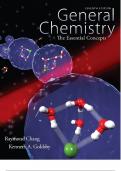Exam (elaborations)
Test Bank For General Chemistry The Essential Concept 7Th Edition Raymond By Chang
- Course
- Institution
Chapter 01: Introduction 1. A tentative explanation for a set of observations that can be tested by further experimentation is referred to as A) a hypothesis. B) a law. C) a theory. D) none of the above. Ans: A Category: Easy Section: 1.2 2. A concise verbal or mathematical statement of a relat...
[Show more]



